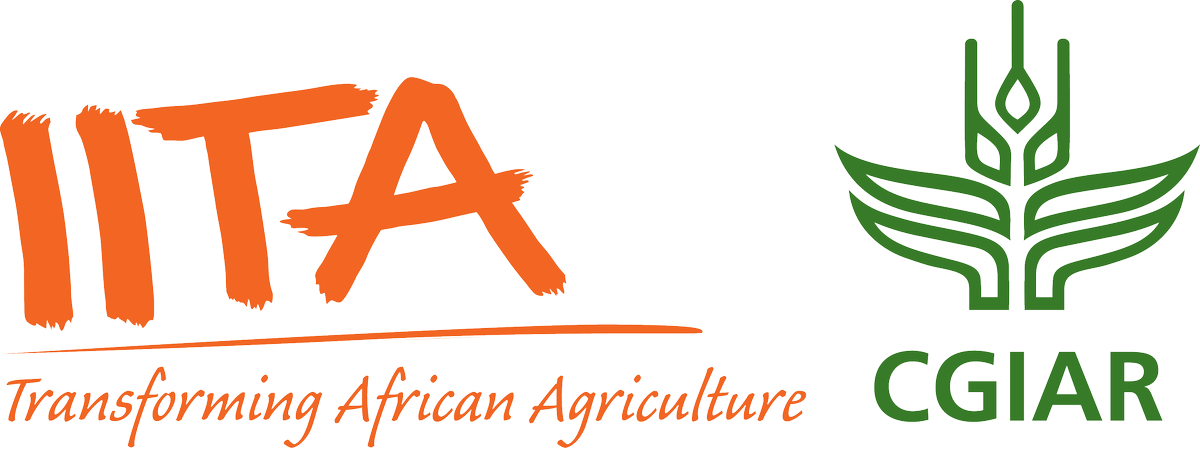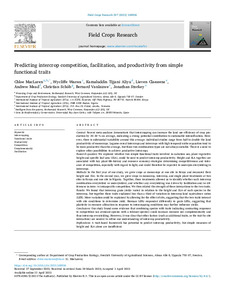| dc.contributor.author | MacLaren, C. |
| dc.contributor.author | Waswa, W. |
| dc.contributor.author | Aliyu, K.T. |
| dc.contributor.author | Claessens, L. |
| dc.contributor.author | Mead, A. |
| dc.contributor.author | Schöb, C. |
| dc.contributor.author | Vanlauwe, B. |
| dc.contributor.author | Storkey, J. |
| dc.date.accessioned | 2023-04-19T09:51:50Z |
| dc.date.available | 2023-04-19T09:51:50Z |
| dc.date.issued | 2023-06-01 |
| dc.identifier.citation | MacLaren, C., Waswa, W., Aliyu, K. T., Claessens, L., Mead, A., Schöb, C., ... & Storkey, J. (2023). Predicting intercrop competition, facilitation, and productivity from simple functional traits. Field Crops Research, 297: 108926, 1-15. |
| dc.identifier.issn | 0378-4290 |
| dc.identifier.uri | https://hdl.handle.net/20.500.12478/8143 |
| dc.description.abstract | Context Recent meta-analyses demonstrate that intercropping can increase the land use efficiency of crop production by 20–30 % on average, indicating a strong potential contribution to sustainable intensification. However, there is substantial variability around this average: individual studies range from half to double the land productivity of monocrops. Legume-cereal intercrops and intercrops with high temporal niche separation tend to be more productive than the average, but these two combination types are not always suitable. There is a need to explore other possibilities to achieve productive intercrops. Research question We explored whether two simple functional traits involved in radiation use, plant vegetative height and specific leaf area (SLA), could be used to predict intercrop productivity. Height and SLA together are associated with key plant life-history and resource economy strategies determining competitiveness and tolerance of competition, especially with regard to light, and could therefore be expected to underpin overyielding in intercrops. Methods In the first year of our study, we grew crops as monocrops at one site in Kenya and measured their height and SLA. In the second year, we grew crops in monocrop, intercrop, and single plant treatments at two sites in Kenya and one site in Nigeria. Together, these treatments allowed us to identify whether each intercrop combination overyielded or underyielded, and whether any overyielding was driven by facilitation and/or differences in inter- vs intraspecific competition. We then related the strength of these interactions to the two traits. Results We found that intercrop grain yields varied in relation to the height and SLA of each species in the intercrop, but together these traits explained less than a third of variation in intercrop land equivalence ratios (LER). More variation could be explained by allowing for the effect of site, suggesting that the two traits interact with site conditions to determine yield. Biomass LERs responded differently to grain LERs, suggesting that plasticity in resource allocation in response to intercropping conditions may further influence yields. Conclusions Our study found some evidence that combining species with traits indicating contrasting responses to competition (an avoidant species with a tolerant species) could increase resource use complementarity and thus intercrop overyielding. However, it was clear that other factors (such as additional traits, or the trait by site interaction) are needed to refine our understanding of intercrop productivity. Implications A trait-based framework has potential to predict intercrop productivity, but simple measures of height and SLA alone are insufficient. |
| dc.description.sponsorship | Global Challenge Research Fund |
| dc.format.extent | 1-15 |
| dc.language.iso | en |
| dc.subject | Intercropping |
| dc.subject | Biological Traits |
| dc.subject | Productivity |
| dc.subject | Sub-Saharan Africa |
| dc.title | Predicting intercrop competition, facilitation, and productivity from simple functional traits |
| dc.type | Journal Article |
| cg.contributor.crp | Maize |
| cg.contributor.crp | Roots, Tubers and Bananas |
| cg.contributor.affiliation | Rothamsted Research, United Kingdom |
| cg.contributor.affiliation | Swedish University of Agricultural Sciences |
| cg.contributor.affiliation | International Institute of Tropical Agriculture |
| cg.contributor.affiliation | Universidad Rey Juan Carlos, Spain |
| cg.coverage.region | Africa |
| cg.coverage.region | East Africa |
| cg.coverage.region | West Africa |
| cg.coverage.country | Kenya |
| cg.coverage.country | Nigeria |
| cg.coverage.hub | Eastern Africa Hub |
| cg.coverage.hub | Headquarters and Western Africa Hub |
| cg.researchtheme | Natural Resource Management |
| cg.isijournal | ISI Journal |
| cg.authorship.types | CGIAR and advanced research institute |
| cg.iitasubject | Agronomy |
| cg.iitasubject | Crop Systems |
| cg.iitasubject | Food Security |
| cg.iitasubject | Plant Breeding |
| cg.iitasubject | Plant Production |
| cg.journal | Field Crops Research |
| cg.notes | Open Access Article; Published online: 12 Apr 2023 |
| cg.accessibilitystatus | Open Access |
| cg.reviewstatus | Peer Review |
| cg.usagerightslicense | Creative Commons Attribution 4.0 (CC BY 0.0) |
| cg.targetaudience | Scientists |
| cg.identifier.doi | https://doi.org/10.1016/j.fcr.2023.108926 |
| cg.iitaauthor.identifier | Lieven Claessens: 0000-0003-2961-8990 |
| cg.iitaauthor.identifier | bernard vanlauwe: 0000-0001-6016-6027 |
| cg.futureupdate.required | No |
| cg.identifier.issue | 108926 |
| cg.identifier.volume | 297 |

